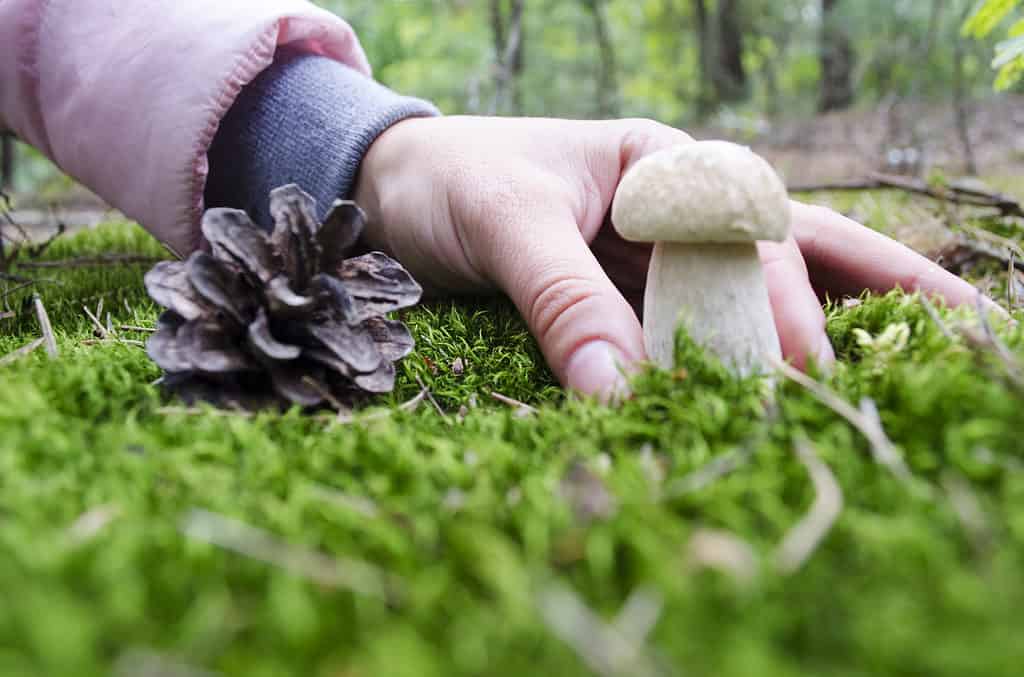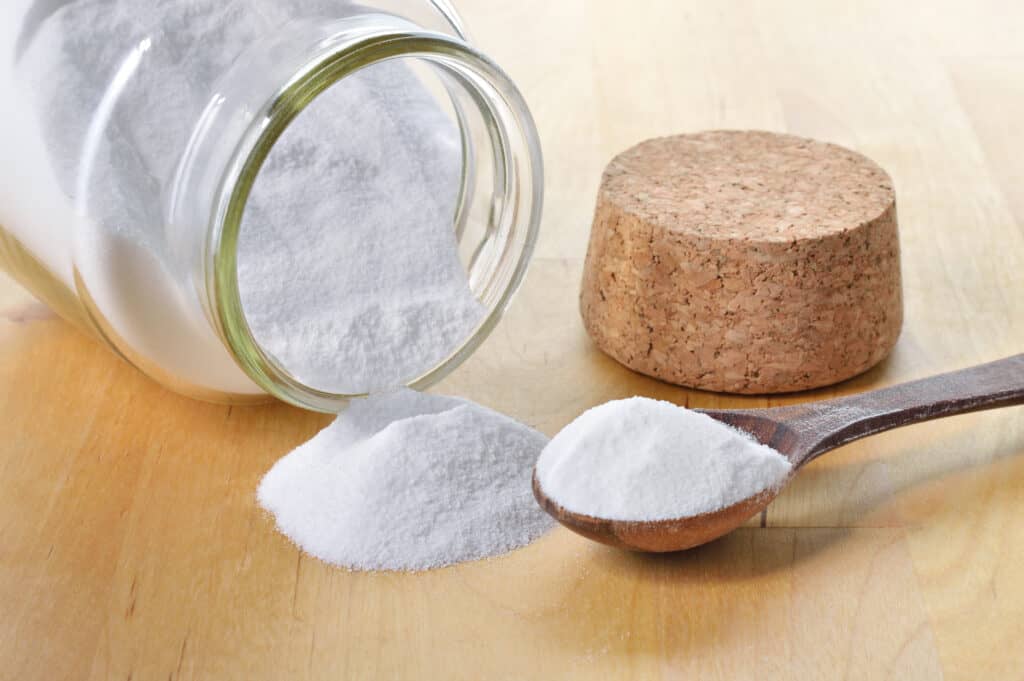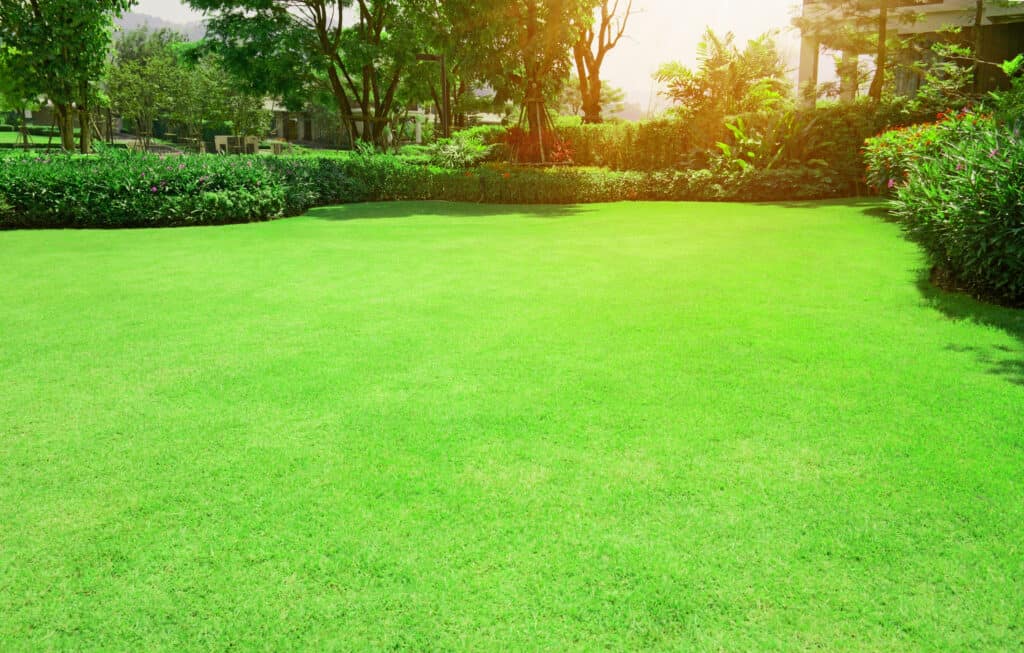Everyone gets a kick out of owning the most beautiful lawn in the neighborhood. But what happens when mushrooms pop up unexpectedly, robbing your dazzling yard of its allure and – even worse – threatening to sicken your little ones and pets?
As harsh as it might sound, killing mushrooms is the best way to permanently remove them from your backyard and enhance your lawn’s appearance. If this is your first time, you’re probably wondering how to do so safely and quickly. But don’t fret; we’ve got you covered. Let’s dive into the easiest ways to deal with your mushroom problem!
Pull Them Out of the Ground

©iStock.com/Oksana Styranets
Digging up the mushrooms is the most straightforward strategy to kill them. Do this as soon as they appear. If you wait too long, they’ll eventually release spores, leading to the growth of more troops. At the same time, note that this process entails more than just plucking the mushrooms out; you must dispose of the soil around them to eliminate the fungi.
Avoid adding the mushrooms to your compost pile after pulling them out, as they’ll grow again. Instead, seal them in a plastic bag using a rubber band and throw the bag into your trash can.
As a rule, you should prioritize your safety when removing mushrooms from your yard. Wear protective gardening gloves to avoid cutting your fingers with your garden knife. Putting on a mask is also an excellent idea, especially if your lawn is full of clusters and you’ve been exposed to the fungi many times before. Long-term exposure to mushroom spores can cause lung inflammation.
Spray a Vinegar Solution
Another practical method to do away with mushrooms is the use of white vinegar. Rather than use the vinegar bottle you have in your kitchen, purchase a quality garden or weed-killing vinegar from a nearby hardware store. The solution contains acetic acid, which does a fantastic job of killing the fungi. Applying it to the mushroom’s surface burns out the fungi and destroys the spores, deterring their propagation.
Unfortunately, vinegar is only a temporary solution to your mushroom predicament. The body under the ground (mycelia) lives on, meaning the mushrooms will pop up again after a while. You’ll therefore need to spray the solution repeatedly to control the fungi’s growth.
Here are some crucial measures to take when killing mushrooms using vinegar:
Dilute the Vinegar
Dilute the liquid by mixing one part vinegar with four parts water in a plastic container. Then, carefully pour the mixture into a spray bottle for easy application.
Some homeowners put their white vinegar solutions into sprayers to sprinkle on the mushroom colonies on their lawns. While this is a fast and effective method to kill the mushrooms and the mycelia, it burns out the grass. So, unless you plan to reseed later, using a spray bottle is the better option.
Pick the Right Day
Don’t apply white vinegar to the mushrooms on a rainy day. The water will wash away the solution, allowing the fungi to keep growing. Additionally, ensure you spray when there’s little to no wind outside. This will make it easier to target the sporophores.
Before choosing when to spray vinegar on the mushrooms, gather enough forecasting data from a reliable source in your area. If you’re in the US, the National Weather Service is your best bet.
Stay Safe
The mushrooms in your garden are an eye sore. But regardless of how much you’d love to get rid of them, never ignore your safety. Reckless or hurried spraying could burn your skin or even damage your eyes.
Some mushroom species are toxic; their spores can trigger allergy symptoms such as sneezing, skin irritation, and a runny nose. We strongly recommend that you put on high-quality goggles and hand gloves when applying the solution.
Wait up to four days for the white vinegar to kill the mushrooms. If some still linger, repeat these steps until they die.
Apply Soapy Water
Many people use soapy water to kill garden mushrooms because it’s easy and convenient. Here’s what you should do to make your solution:
- Put two to three gallons of water in a plastic container or bucket
- Add one to two tablespoons of dish soap
- Stir the mixture
After making the soapy water concoction, poke holes on your yard and pour the solution into them. Give it time to soak into the soil and kill the fungi roots. You can achieve the best results by repeating this process a few times daily for a week. Keep in mind, however, that this method only makes the mushrooms go dormant for a while by inhibiting the mycelium’s growth; it doesn’t do away with them completely.
Which Dish Soap Removes Mushrooms?
This is a common question among homeowners looking to free their yard from annoying mushroom growth. If used properly, any mild dish soap will eliminate the fungus. Please avoid using strong detergents, as they may dry out the grass near the clusters and limit growth.
Use a High Nitrogen Fertilizer
Applying a high-nitrogen fertilizer to your garden is another excellent way to kill mushrooms. This chemical substance facilitates swift decomposition of organic matter, eventually leaving the fungi with nothing to feed on.
As is the case with the rest of the other mushroom-killing methods on this list, don’t expect instant results. This particular method will require you to apply high nitrogen fertilizer annually to slowly eliminate the mushrooms. Add some phosphorus and potassium to the soil around the fungi to quicken the decomposition process.
Ideally, you should use a pound of nitrogen for every 1,000 square feet, in addition to one and two parts of phosphorus and potassium, respectively.
Use Baking Soda

©Geo-grafika/Shutterstock.com
Although baking soda or sodium bicarbonate is not a fungicide, it works wonders when it comes to eliminating mushrooms. The compound improves the soil’s pH and discourages fungal growth. For it to work, however, you’ll have to use it several times for the fungi to completely disappear.
Follow these steps to get rid of mushrooms using baking soda:
- Pour water into a container
- Add two tablespoons of sodium bicarbonate (per liter)
- Stir the mixture until the baking soda dissolves completely
- Pour the solution over the area with mushroom growth and the surrounding region
Most homeowners prefer this method of killing mushrooms since it’s safe for children and pets at home. Moreover, it’s cheaper than purchasing expensive fungicides, and it works if you do it consistently. The only downside is that nearby vegetation might become dormant as you’ll be significantly altering the soil’s pH the more you do this.
Aerate Your Lawn
Aeration is a fantastic idea if you’re hoping to improve your lawn’s appearance and get rid of the mushrooms growing on it simultaneously. The process allows more oxygen and water to penetrate the soil, killing the fungus in it.
You have two tool options when aerating your lawn to kill mushrooms—a plug aerator and a spike aerator. The former digs out a core of the soil, while the latter leverages a prong or fork to poke holes into the ground. Homeowners believe spike aerators are less effective because they can increase compaction in the regions around the depressions they create.
Regardless of the machine you opt to use, aerating can end your mushroom problem a lot sooner than other methods. Fortunately, plug and spike aerators are available in most home improvement and garden stores. However, you don’t need to buy them since most businesses rent out the machines and even provide instructions on how to use them.
Apply a Fungicide Spray
If all the methods above don’t work as effectively as expected, use a quality fungicide to treat your lawn. Dilute the chemical with water and pour it into a pump spray to apply on the affected garden area. When you spray the fungicide consistently and in the right way, you’ll observe awesome results within three to eight days, depending on the fungicide you choose.
Also, keep in mind that fungicides are toxic. Handle the product with care to avoid irritation to your eyes and skin. Inhaling fungicides could also lead to throat irritation, coughing, and sneezing. After spraying the chemicals to your backyard, keep your kids and pets away from the outdoor space. Maintain regular checks on your yard and collect dead mushrooms and dispose of them properly before they propagate spores.
Here are four other rules to follow when applying fungicides to your backyard:
Read the Label
All fungicides come with a label with these pieces of information:
- The fungicide manufacturer or brand
- Instructions to apply the chemical
- Ingredients used to make the fungicide
- Equipment required to avoid exposure to the product
- Environmental hazards
- Instruction on how to store and dispose of the fungicide
Always read the product label before using a fungicide to kill mushrooms. It lets you know the ins and outs of the product and also guides you on how to use it safely and correctly. By reading the label, you can also know which protective gear to use when applying the chemical.
Don’t Eat or Smoke While Spraying
Eating and smoking when spraying fungicides is a big no-no. You’re bound to transfer traces of the chemical from your hands to your mouth, which may result in symptoms such as:
- Nausea and vomiting
- Diarrhea
- Fatigue
- Dizziness
- Headache
- Increased salivation
Prepare the Right Amount
Dilute your fungicide using the specified proportions before spraying it on the mushrooms and surrounding areas. You should only prepare enough for a single application. Storing the solution for future use isn’t an option, as the chemical will degrade over time, rendering it ineffective for later use.
Store the Fungicide Safely
Safe fungicide storage is paramount to the well-being of your children, pets, and anyone else who might tamper with it. Avoid storing the chemical in food containers such as milk bottles. Instead, ensure it stays in its original container to make it easy for anyone to stick to its intended use.
Additionally, store the fungicides in locations children can’t reach, such as the top shelf of a locked cabinet in your garden shed. And refasten the caps to reduce a little one’s chance of opening the containers.
Invaluable Tips to Prevent Mushrooms from Growing Back
Mushrooms can be a nuisance because they tend to pop back up quickly, especially if the conditions are right—plenty of moisture and little light. This section will highlight the steps to ensure the fungi don’t take over your backyard again.
Keep Your Yard Clean

©aimful/Shutterstock.com
Ensuring your backyard is always tidy ranks among the most effective strategies to prevent mushroom growth. If your lawn is full of debris and other objects, moisture builds up fast, leading to more shaded areas that encourage mushrooms to grow back.
Consider these strategies to maintain your yard:
- Rake leaves
- Prune flowering shrubs
- Redraw the garden beds
Mow Your Lawn Regularly
Cutting the grass on your lawn is essential to tidying it up and preventing mushrooms from growing back. Mowing not only gets rid of existing fungi but also removes any remnants, minimizing their chances of spreading spores. Here are several other perks you stand to enjoy from maintaining a clean yard:
- A good-looking outdoor space
- Minimal pests and weeds
- A space where you can easily spot and get rid of debris
- A good place to connect with nature
- A clean space to relax and play with your kids
Cover Up the Affected Spots
Sometimes, mushrooms can keep growing on a hot spot. If you’re tired of implementing mushroom-killing solutions or treating the space, covering it up will help to deter the fungi from sprouting again. One of the most convenient ways to cover up a mushroom-prone spot is to build a gazebo. Besides keeping the mushrooms at bay, doing so will provide plenty of shade on sunny days and provide a place to relax with your family and friends. The structure will further increase your backyard’s visual appeal.
Of course, before adding the structure to your garden, it’s wise to consult a professional who can guide you in choosing its shape, design, and size.
Practical Methods to Kill Mushrooms
You have every reason to eliminate the mushrooms on your lawn. Although most fungi aren’t dangerous, some species are poisonous. If your furry friend or little one consumes the latter, they’re likely to suffer symptoms such as weakness, poor coordination, and in some cases, death.
The presence of mushrooms in your backyard ruins your green and lush garden. The practical strategies listed in this article will help you kill those stubborn clusters and ensure they don’t grow back to create a safe, gorgeous outdoor space.
It’s also worth mentioning that mushrooms can grow indoors if you have potted plants. Since the plants have easier access to water and warm air, they provide the perfect environment for the fungi to thrive. In such a scenario, your best move will be to simply uproot the mushrooms. Fungicides and solutions like vinegar and soapy water will damage your plant. Additionally, don’t overwater the plants. This will ensure that the topsoil is always dry, which will discourage further mushroom growth.
The post How to Kill Mushrooms appeared first on AZ Animals.
from Animal News, Facts, Rankings, and More! - AZ Animals https://ift.tt/fJdhQm8